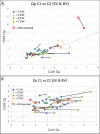Fick versus flow: a real-time invasive cardiovascular magnetic resonance (iCMR) reproducibility study
- PMID: 34275477
- PMCID: PMC8287667
- DOI: 10.1186/s12968-021-00784-7
Fick versus flow: a real-time invasive cardiovascular magnetic resonance (iCMR) reproducibility study
Abstract
Background: Cardiac catheterization and cardiovascular magnetic resonance (CMR) imaging have distinct diagnostic roles in the congenital heart disease (CHD) population. Invasive CMR (iCMR) allows for a more thorough assessment of cardiac hemodynamics at the same time under the same conditions. It is assumed but not proven that iCMR gives an incremental value by providing more accurate flow quantification.
Methods: Subjects with CHD underwent real-time 1.5 T iCMR using a passive catheter tracking technique with partial saturation pulse of 40° to visualize the gadolinium-filled balloon, CMR-conditional guidewire, and cardiac structures simultaneously to aid in completion of right (RHC) and left heart catheterization (LHC). Repeat iCMR and catheterization measurements were performed to compare reliability by the Pearson (PCC) and concordance correlation coefficients (CCC).
Results: Thirty CHD (20 single ventricle and 10 bi-ventricular) subjects with a median age and weight of 8.3 years (2-33) and 27.7 kg (9.2-80), respectively, successfully underwent iCMR RHC and LHC. No catheter related complications were encountered. Time taken for first pass RHC and LHC/aortic pull back was 5.1, and 2.9 min, respectively. Total success rate to obtain required data points to complete Fick principle calculations for all patients was 321/328 (98%). One patient with multiple shunts was an outlier and excluded from further analysis. The PCC for catheter-derived pulmonary blood flow (Qp) (0.89, p < 0.001) is slightly lower than iCMR-derived Qp (0.96, p < 0.001), whereas catheter-derived systemic blood flow (Qs) (0.62, p = < 0.001) was considerably lower than iCMR-derived Qs (0.94, p < 0.001). CCC agreement for Qp at baseline (C1-CCC = 0.65, 95% CI 0.41-0.81) and retested conditions (C2-CCC = 0.78, 95% CI 0.58-0.89) were better than for Qs at baseline (C1-CCC = 0.22, 95% CI - 0.15-0.53) and retested conditions (C2-CCC = 0.52, 95% CI 0.17-0.76).
Conclusion: This study further validates hemodynamic measurements obtained via iCMR. iCMR-derived flows have considerably higher test-retest reliability for Qs. iCMR evaluations allow for more reproducible hemodynamic assessments in the CHD population.
Keywords: Cardiac catheterization; Congenital heart disease; Device tracking; Interventional CMR; Magnetic resonance imaging; Reproducibility.
© 2021. The Author(s).
Conflict of interest statement
Whilst Nano4Imaging did not provide any financial support for this study, they have provided travel expenses for the senior author (SR) for attendance at an international conference to present related work.
Figures







References
-
- Fogel MA, Pawlowski TW, Whitehead KK, Harris MA, Keller MS, Glatz AC, Zhu W, Shore D, Diaz LK, Rome JJ. Cardiac magnetic resonance and the need for routine cardiac catheterization in single ventricle patients prior to Fontan: a comparison of 3 groups: pre-Fontan CMR versus cath evaluation. J Am Coll Cardiol. 2012;60(12):1094–1102. doi: 10.1016/j.jacc.2012.06.021. - DOI - PubMed
-
- Brown DW, Gauvreau K, Powell AJ, Lang P, Del Nido PJ, Odegard KC, Geva T. Cardiac magnetic resonance versus routine cardiac catheterization before bidirectional Glenn anastomosis: long-term follow-up of a prospective randomized ) trial. J Thorac Cardiovasc Surg. 2013 doi: 10.1016/j.jtcvs.2012.12.079. - DOI - PubMed
-
- Veeram Reddy SR, Arar Y, Zahr RA, et al. Invasive cardiovascular magnetic resonance (iCMR) for diagnostic right and left heart catheterization using an MR-conditional guidewire and passive visualization in congenital heart disease. J Cardiovasc Magn Reson. 2020;22:20. doi: 10.1186/s12968-020-0605-9. - DOI - PMC - PubMed
-
- Kakareka JW, Faranesh AZ, Pursley RH, Cambell-Washburn A, Herzka DA, Rogers T, Kanter J, Ratnayaka K, Lederman RJ, Pohida TJ. Physiological recording in the MRI environment (PRiME): MRI-compatible hemodynamic recording system. IEEE J Transl Eng Health Med. 2018;6:1. doi: 10.1109/JTEHM.2018.2807813. - DOI - PMC - PubMed
Publication types
MeSH terms
LinkOut - more resources
Full Text Sources
Medical
Miscellaneous

